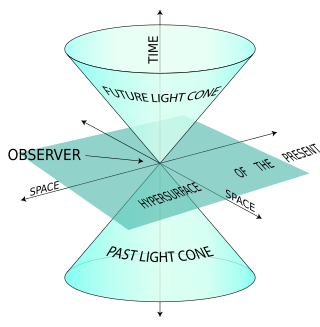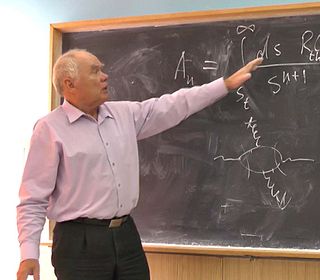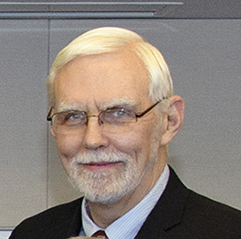Related Research Articles

In theoretical physics, quantum chromodynamics (QCD) is the study of the strong interaction between quarks mediated by gluons. Quarks are fundamental particles that make up composite hadrons such as the proton, neutron and pion. QCD is a type of quantum field theory called a non-abelian gauge theory, with symmetry group SU(3). The QCD analog of electric charge is a property called color. Gluons are the force carriers of the theory, just as photons are for the electromagnetic force in quantum electrodynamics. The theory is an important part of the Standard Model of particle physics. A large body of experimental evidence for QCD has been gathered over the years.

Gerardus (Gerard) ’t Hooft is a Dutch theoretical physicist and professor at Utrecht University, the Netherlands. He shared the 1999 Nobel Prize in Physics with his thesis advisor Martinus J. G. Veltman "for elucidating the quantum structure of electroweak interactions".

Richard Keith Ellis, is a British theoretical physicist, working at the University of Durham, and a leading authority on perturbative quantum chromodynamics and collider phenomenology.

The light-front quantization of quantum field theories provides a useful alternative to ordinary equal-time quantization. In particular, it can lead to a relativistic description of bound systems in terms of quantum-mechanical wave functions. The quantization is based on the choice of light-front coordinates, where plays the role of time and the corresponding spatial coordinate is . Here, is the ordinary time, is one Cartesian coordinate, and is the speed of light. The other two Cartesian coordinates, and , are untouched and often called transverse or perpendicular, denoted by symbols of the type . The choice of the frame of reference where the time and -axis are defined can be left unspecified in an exactly soluble relativistic theory, but in practical calculations some choices may be more suitable than others.
Stanley J. Brodsky is an American theoretical physicist and emeritus professor in the SLAC Theory Group at the SLAC National Accelerator Laboratory at Stanford University.
Alfred H. Mueller is an American theoretical physicist, and the Enrico Fermi Professor of Physics at Columbia University.
In quantum field theory, initial and final state radiation refers to certain kinds of radiative emissions that are not due to particle annihilation. It is important in experimental and theoretical studies of interactions at particle colliders.
Twistor string theory is an equivalence between N = 4 supersymmetric Yang–Mills theory and the perturbative topological B model string theory in twistor space.

In mathematics and theoretical physics, an amplituhedron is a geometric structure introduced in 2013 by Nima Arkani-Hamed and Jaroslav Trnka. It enables simplified calculation of particle interactions in some quantum field theories. In planar N = 4 supersymmetric Yang–Mills theory, also equivalent to the perturbative topological B model string theory in twistor space, an amplituhedron is defined as a mathematical space known as the positive Grassmannian.

Victor Sergeevich Fadin is a Russian physicist, well known for his contributions to theoretical physics and particle physics. He is a principal researcher at Budker Institute of Nuclear Physics (BINP) and professor of theoretical physics at Novosibirsk State University (NSU).
Davison "Dave" Eugene Soper is an American theoretical physicist specializing in high energy physics.
John Clements Collins is a British-born American theoretical physicist and professor of physics at Pennsylvania State University. He attended the University of Cambridge where he obtained a B.A. in mathematics 1971 and a Ph.D. in theoretical physics in 1975. He worked as a postdoc and assistant professor from 1975 to 1980 at Princeton University. Collins was part of the faculty of the Illinois Institute of Technology from 1980 to 1990. From 1990 to the present, he has been a faculty member in the department of physics at Pennsylvania State University where he currently holds the position of distinguished professor. He is a Fellow of the American Physical Society and received the Guggenheim Fellowship in 1986. In 2009, he was awarded the Sakurai Prize along with R. Keith Ellis and Davison E. Soper.

The light-front quantization of quantum field theories provides a useful alternative to ordinary equal-time quantization. In particular, it can lead to a relativistic description of bound systems in terms of quantum-mechanical wave functions. The quantization is based on the choice of light-front coordinates, where plays the role of time and the corresponding spatial coordinate is . Here, is the ordinary time, is a Cartesian coordinate, and is the speed of light. The other two Cartesian coordinates, and , are untouched and often called transverse or perpendicular, denoted by symbols of the type . The choice of the frame of reference where the time and -axis are defined can be left unspecified in an exactly soluble relativistic theory, but in practical calculations some choices may be more suitable than others. The basic formalism is discussed elsewhere.
Edward William Nigel Glover FRS is a British particle physicist. He is a professor of physics at the University of Durham. He graduated from Downing College, Cambridge, with a first in Natural Sciences, and went on to complete a doctorate at Hatfield College, Durham.
Double copy theory is a theory in theoretical physics, specifically in quantum gravity, that hypothesizes a perturbative duality between gauge theory and gravity. The theory says that scattering amplitudes in non-Abelian gauge theories can be factorized such that replacement of the color factor by additional kinematic dependence factor, in a well-defined way, automatically leads to gravity scattering amplitudes. It was first written down by Zvi Bern, John Joseph Carrasco and Henrik Johansson in 2010 and was sometimes known as the BCJ duality after its creators or as "gravity = gauge × gauge".

Zvi Bern is an American theoretical particle physicist. He is a professor at University of California, Los Angeles (UCLA).
Martin B. Einhorn is an American theoretical physicist.

G. Peter Lepage is a Canadian American theoretical physicist and an academic administrator. He was the Harold Tanner Dean of the College of Arts and Sciences at Cornell University from 2003 to 2013.

Bernhard Mistlberger is an Austrian theoretical particle physicist known for his significant work in the area of quantum field theory. He is known for multi-loop calculations in quantum chromodynamics (QCD), including the first high-precision theoretical predictions of Higgs and vector boson production at the Large Hadron Collider.
The SLAC Theory Group is the hub of theoretical particle physics research at the SLAC National Accelerator Laboratory at Stanford University. It is a subdivision of the Elementary Particle Physics (EPP) Division at SLAC.
References
- ↑ Laudatio Sakurai Prize
- ↑ Dixon, Lance J.; Kaplunovsky, Vadim S.; Louis, Jan (27 May 1991). "Moduli dependence of string loop corrections to gauge coupling constants". Nuclear Physics B. 355 (3): 649–688. Bibcode:1991NuPhB.355..649D. doi:10.1016/0550-3213(91)90490-O. OSTI 1449107.
- ↑ "2022 NAS Election".
- ↑ "The 2023 Galileo Galilei Medal Goes to Zvi Bern, Lance Dixon and David Kosower". Interactions | Istituto Nazionale di Fisica Nucleare. Retrieved 2023-02-17.